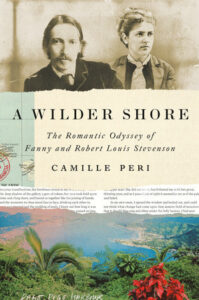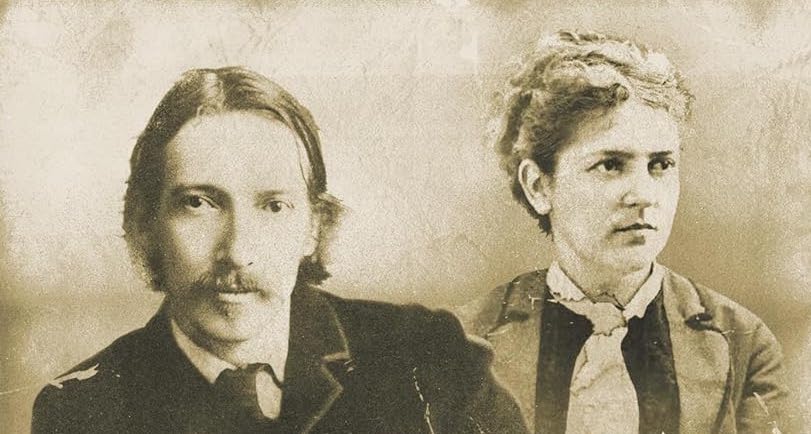“She was the only woman in the world worth dying for.” It was these words, which I came across in a reference to Fanny Van de Grift Stevenson, that first caught my attention. They were written by an admirer, not the man she devoted her life to—her famous husband, Robert Louis Stevenson. But Louis, as he was called, actually did risk his life to get to her, crossing the world when he was in ill health, because he felt he could not live without her. “Honour, anger, valour, fire” were qualities he attributed to Fanny, who sustained him with “a love that life could never tire, evil quench, nor death stir,” as he wrote in one poem.
As I delved deeper into their story, I came to realize that, without Fanny, there would be no Robert Louis Stevenson as we know him. He probably would not have written Treasure Island or finished Kidnapped, and Dr Jekyll and Mr Hyde might well have been a different story from the one the world knows today. Without Fanny, Louis probably would not have become one of the most famous and beloved authors in the world.
Theirs was an unlikely Victorian love story: He was a university-educated writer from a prominent family in Scotland; she was a high school graduate from the rustic Midwest. He was ambitious but in frail health and adrift, penning magazine essays that would likely be forgotten. She was forceful and determined—whether she was seeking her fortune in the Nevada silver rush or studying art in Paris. She was ten years his senior and married, with children, when they met. How could a union between them work—or even happen?
Without Fanny, Louis probably would not have become one of the most famous and beloved authors in the world.
It was the fascinating and fruitful partnership between Fanny and Robert Louis Stevenson that compelled me to write this book. When the sickly Scottish writer and the American runaway wife met, improbably, in an art colony in France, both were seeking escape from a bland Victorian bourgeois life. They found it in each other. Their marriage was tumultuous, a ship tossing in a frothing sea. But together they created a beautiful adventure that would not have been possible without the other. A Wilder Shore is a portrait of these two extraordinary people and an exploration of the union that stimulated, frustrated, and ultimately sustained them.
Louis was a self-described “chronic sickest,” prone to violent, bloody coughing fits that appeared to be caused by tuberculosis. But he had the heart of an adventurer. This book travels the world with him and Fanny as they seek better health for him, a looser lifestyle, and more creative freedom—a journey that included their honeymoon squatting in an abandoned silver mine and ended with them living in Samoa, where they joined the native islanders’ fight for independence from imperialist powers. I followed their path—from France and Britain to New York and San Francisco, and ultimately to the Pacific Islands—to bring their story to life.
A Wilder Shore may challenge some readers’ expectations of RLS (another nickname), who is often thought of simply as an entertaining author of boys’ books and a man who was childish himself. In fact, he heroically overcame incredibly daunting medical challenges to write some of the most towering, indelible prose in Western literature. “He seemed to pick the right word up on the point of his pen, like a man playing spillikens,” author G. K. Chesterton wrote. Through it all, with Fanny, Louis retained the imaginative powers of youth that fueled his writing and his life.
Fanny has suffered the unflattering fate of most literary wives, whom critics historically render invisible or pick apart to find evidence of how they helped or hindered their husbands’ careers. This leaves them only half formed on the printed page. Depictions of Fanny often vacillate between extremes: She is either a skilled and caring helpmate or, more often, a prickly, selfish drain on her husband. Many previous Stevenson biographies have denigrated her as a “difficult” woman without further exploring her character. No portrayal has captured the complex and dynamic woman she was or the passion, companionship, and creative energy that became the life force of the Stevensons’ marriage.
Fanny was integral to RLS’s writing process—from handling the practical matters of life (including the formidable logistics of moving around the world to keep him alive) to encouraging him to write fiction and to delve into psychology and politics in his work. But she too had a vivid imagination, which she expressed in her own writing and in the way she lived her life.
Fanny left behind several published nonfiction essays and short stories, along with travel narratives and a novel, More New Arabian Nights: The Dynamiter, that she coauthored with Louis. Yet most of her fiction and nonfiction has been dismissed or ignored—even by her own biographers. In part, this began with Louis’s literary clique, who branded her primitive—even “savage”—because she was olive skinned and American. A highlight of my research for A Wilder Shore was locating pieces of Fanny’s work that have received no critical attention. They help reveal some of the themes that absorbed her and shaped her influence on Louis, as well as provide a glimpse of nineteenth-century popular magazine writing—often the most open path to publication for Victorian women. A Wilder Shore is the first book about the Stevensons to consider the body of Fanny’s work as well as that of her famous husband.
*
The Stevensons were as creative and progressive in their personal life as they were in their writings, and their attempt to build a relatively egalitarian marriage nearly 150 years ago has surprising resonance today. Theirs was an exciting but socially unsettled time, when Victorian norms of gender, social class, race, sexuality, and even marriage were just beginning to erode. Louis admired Fanny for her courage and strong views—qualities then deemed almost exclusively masculine—and she appreciated him for his “feminine” dreaminess and sensitivity. Together they created women characters who broke the rules: a female terrorist, a cross-dressing countess with “manlike ambitions” and a lusty sex drive, a runaway from a religious cult, a dark- skinned British woman impersonating a Cuban slave. Louis wrote of the prejudice against immigrants in the United States, and both wrote of interracial love and marriage. In their South Seas writings, both questioned imperialism and the “scientific” theories about race that were used to justify it. They examined the costs of progress and colonialism on marginalized people and Indigenous cultures.
Achieving parity in marriage was no smooth or easy task. Louis was the peacock in the relationship, the genius and the moneymaker—and, to a great extent, Fanny would see it as her role to keep him alive and writing. There were times when she would feel like a housemaid or nurse; when she had no time even to contemplate who she was; when she resented the expectation that wives should be grateful for money allotted to them as if it were an unearned allowance.
The Stevensons’ unconventional partnership allowed…both partners more freedom within Victorian society than they might otherwise have sought or enjoyed.
But although Victorian women were considered biologically suited to the “domestic sphere,” Louis did not expect his wife to contentedly define her life by homemaking. Despite Fanny’s relative lack of education, he depended on her critical insights as much or more than those of his snobby male literary colleagues, much to their annoyance. And he saw to it that she was formally credited as coauthor for a book they wrote together at a time when wives were rarely acknowledged for contributions to their husbands’ work. The couple’s verbal scuffles were notorious, but they were also part of a lifelong conversation that pushed them to evolve and grow.
There were many times during my research that I longed to step into one of the Stevensons’ homes, an experience Fanny’s daughter, Isobel Field, likened to “the rising of a curtain in the theatre.” Half the time, the couple floated in a somewhat surreal world, on drugs that included laudanum (a tincture of opium) and ergotin (a derivative of the main component of LSD)— remedies that were routinely prescribed for serious illnesses like tuberculosis as well as vague Victorian ailments like “the vapours.” Even their dog, Walter, or “Woggs,” was sometimes on drugs for his “fits.” When Fanny and Louis were well, however, they were lively entertainers, hosting evenings of good food and sparkling conversation. Their eclectic collection of guests ranged from literary luminaries like Henry James to eccentrics like Jane Shelley, who kept the heart of the poet Percy Bysshe Shelley, her dead father-in-law, enshrined in her drawing room.
I’d love to witness Louis as he famously paced the room, brilliantly holding forth in English, French, and Latin, and stopping occasionally to perch on anything but a conventional seat—a dizzying practice that inspired the American historian Henry Adams to liken him to an “insane stork.” I might follow my nose to the kitchen to see Fanny, a renowned cook, putting the final touch on dishes from recipes she picked up on her travels, like bouillabaisse or soufflés. In Samoa, where the couple tended to entertain on a grander scale, she might be supervising the roasting of a dozen or more pigs and hundreds of pineapples from their garden.
Fanny once said that Louis “taught me how to live.” The Stevensons’ unconventional partnership allowed Louis more freedom within the cage of his poor health, and both partners more freedom within Victorian society, than they might otherwise have sought or enjoyed. It drove them to crisscross the globe seeking new and astonishing experiences that neither could have pursued alone. This is an intimate window into how they lived and loved—a story that is at once a travel adventure, a journey into the literary creative process, and, I hope, an inspiration for anyone seeking a freer, more unconventional life.
__________________________________

Excerpted from A Wilder Shore: The Romantic Odyssey of Fanny and Robert Louis Stevenson by Camille Peri. Copyright © 2024. Available from Viking Books, an imprint of Penguin Publishing Group, a division of Penguin Random House, LLC.

